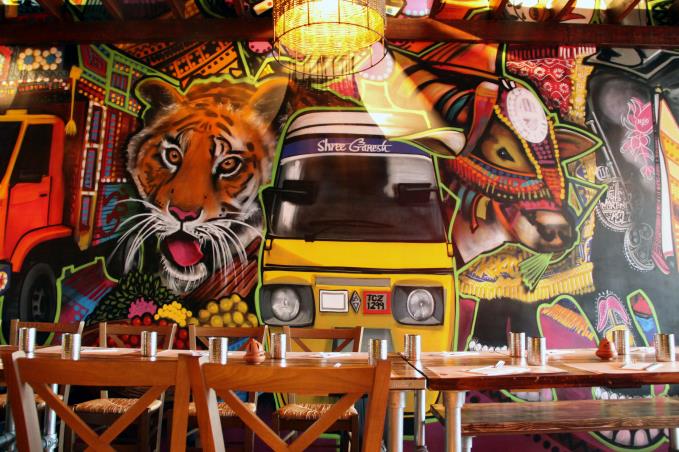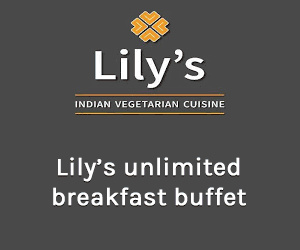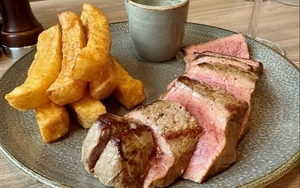Promotion
Indian Tiffin Room has been causing a positive stir ever since it first opened in a small terraced restaurant in a Cheadle side street in 2014. It reflects all that a modern British Indian restaurant should be and has won a string of awards...including being voted third best-rated Indian restaurant in the UK on Trip Advisor. Their loyal following meant that launching a much larger branch in First Street in 2016 was simply the natural thing to do and we’re looking forward to seeing how the brand further develops.
Even second or third generation Indians who have always lived in this country aren’t used to this kind of food as it’s completely different to what they might have been brought up with
ITR was one of the first ‘next generation’ Indian restaurants to do away with ‘old school’ curry favourites and focus on more interesting ‘street food’ dishes; small sharing plates that had more of an urban feel, using freshly prepared ingredients, aromatic spices and added texture. It also took the focus away from the generic curry, highlighting the fact that ‘Indian food’ is full of subtle regional variations and how different areas within the continent specialise in certain dishes inspired by culture, religion, the climate and the territory.
It was a big move from a small restaurant in a Cheadle side street to a much larger unit in City Centre Manchester. What made you go for it?
Srini: “After the success of our Cheadle restaurant, we knew that in terms of business expansion, there was always room for a bigger venue, but we wanted to do it in a place that where people would understand what we do. In the curry mile we felt we’d just get mixed up with the rest of them. We were scouting a few different locations in the city centre and the suburbs, but we narrowed it down this one because we’re next to Home cinema which attracts cultural people who appreciate our kind of food.”

Did the quick success of Cheadle take you by surprise?
Srini: “We were prepared for the worst – you have to be”
Suresh: “the first month was fairly slow considering we had done zero marketing, but things built up so in the second month we got busier. It’s quite a small restaurant. We actually had to spend quite a lot of time explaining the menu to our customers and people started to see it as more than a restaurant; a journey of Indian street food. They would come in again with friends and ask us to explain the menu again ‘the way you do it’ and it became like a show. We quite enjoy that to be honest.”
Do you see yourselves as ambassadors for Indian street food?
Suresh: “Srini ended up doing a special training course so that every single person who worked for ITR understood the menu fully.”
Srini: “We have eleven different nationalities working with us in our Manchester team (Spanish, Polish, Czech Republic, Singapore etc) so things were easier in the Cheadle branch when we were the face of the restaurant with only one other guy with an Indian background. Here, the challenge was getting everyone on the same page. We want them to express themselves, give them freedom to use their own words, but at the same time keep in mind the context of what we’re all about. Everyone here now really enjoys explaining to the customers because it makes them feel a part of India.”
Were you worried about the competition in the city centre?
Suresh: “yes and no. There are some big boys in town and we are little fish from Cheadle, but we were confident in our own menu because nobody in Manchester can do what we do. We’re still feeling confident.”
So you’ve not lost any Cheadle customers by coming here?
Suresh: “We could have gone into Wilmslow or Hale, as a lot of clients were coming from there to Cheadle but this a completely different catchment for us.”
Srini: “Timing was important too. If we’d waited another year, then competitors with some financial backing would have steamed ahead and done something similar under their own brand.”

Has it been everything that you’ve wanted?
Suresh: “yes. So far, touch wood, things are going in the right direction. We still have a lot of room for improvement which is great, because we don’t want to hit a level where we think that this is our maximum. Even in another year from now we’ll be another kettle of fish. People will know Indian Tiffin Room a bit more. Coming to Manchester is a different ballgame altogether, even though it’s only a few miles down the road.”
You’ve had some national press which can’t have done you any harm? Including a review in The Daily Mail
Srini: “It was great and luckily it didn’t cause us any harm (laughs) so that was a great start for us and a motivation, not only for me and Srini but for our staff because many of them trained at Cheadle before coming to work in Manchester and they’re still getting to know what ITR is about and to share our vision.”
You’ve also cleverly used social media from day one, embracing the modern way of marketing. Has it worked?
Srini: “Social media was a real boon for us in Cheadle, getting us noticed, both on Twitter and Facebook”
Where did you both meet?
Srini: “We met about 15 years ago when we both came to Manchester to do our post grad. We’re from similar cultural backgrounds in South India; I’ve grown up in Bombay and Suresh came from somewhere more in the south and we became good friends. We were working at the Raddison Hotel at Manchester Airport together, so we’re both experienced food and beverage guys. I went down south for a few years in 2007 and Suresh was working in a hotel in York, but we had a catch up every year and one year we sat down and had a chat about what we could do next.”
Suresh: “We always craved this kind of food. There are restaurants in London who do South Indian specialities and there are certain restaurants in the Wembley/Harrow region which do Gujerati or North Indian type street food, but never a menu with all the varied cuisine. With our food knowledge, we wanted to put it all together in one menu.”
So you found a gap in the market?
Srini: “When we go to India, we don’t just pop in for a dosa. We eat a dosa and a curry. That is what we have grown up eating. We thought that there was no one place here where we could eat some street food and then go onto the main course. To eat like a family in the type of place we’d enjoy when we were kids; eating one meal rather than two meals at different places. But even second or third generation Indians who have always lived in this country aren’t used to this kind of food as it’s completely different to what they might have been brought up with.”

Even the grander London restaurants seem to have abandoned starters and mains for small and large plates, so people are becoming used to ordering in that way. Has that helped you?
Suresh: “yes, there’s been a boom in the street food movement, and you don’t come here to eat one starter and one main course, you’d all share a lot of starters, sides and main dishes.”
South Indian food is predominantly vegetarian, so how come you serve meat as well here?
Suresh: “We didn’t want to restrict ourselves. Even though we are vegetarian ourselves, we wanted to attract a wider range of customers to our restaurants. We wanted to open our places up so that everyone can come and eat together.”
Srini: “Meat plays a big part in the street food concept – especially in the northern part of India because of the influence of the invasions by Mongolians, Turks and the Afghans etc. By restricting ourselves to serving only vegetarian or vegan dishes, we feel we wouldn’t be representing the whole range of interesting Indian street food from all over the continent. We have dishes from north, south, east and west here and that’s what we wanted from day one.”
Suresh; “Each and every dish is authentic and the kind of dish you’d expect to find back in India. Core dishes from the regions they are famous for with their own history.”
Srini; “but we’ve actually made it harder for ourselves. Firstly our chefs have to have the skills to do this kind of food; one person cannot just learn how to do everything - making dosas is one skill and getting the perfect tandoor is another. Sauces are another specialist skill. We also had to get specialist equipment from India because we wanted to be able to offer certain dishes.”
Do you think there’s still room for old school Indian restaurants?
Srini: “Of course. There’s a certain demographic of people who understand what we’re trying to do, and how Indian food should be, but there are lots of people who still think Indian food is a hot curry and a pint. Things are changing slowly.”
Suresh: “Indians love Chinese food, but they like it with spices in it. It’s the same with Italian food. We make pasta at home, but we add Indian spices because we can’t take the blandness of certain foods. British people are generally not afraid of trying new things and don’t feel the need to change things too much except maybe toning down some of the heat.”
Is there going to be a third or even more Indian Tiffin Rooms in the near future?
Srini: “We’d like to keep things just as rumour for now, but we can tell you that we’re working on creating a north west brand.”
Indian Tiffin Room, 2 Isabella Banks Street, First Street, Manchester M15 4RL
 Powered by Wakelet
Powered by Wakelet








